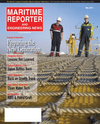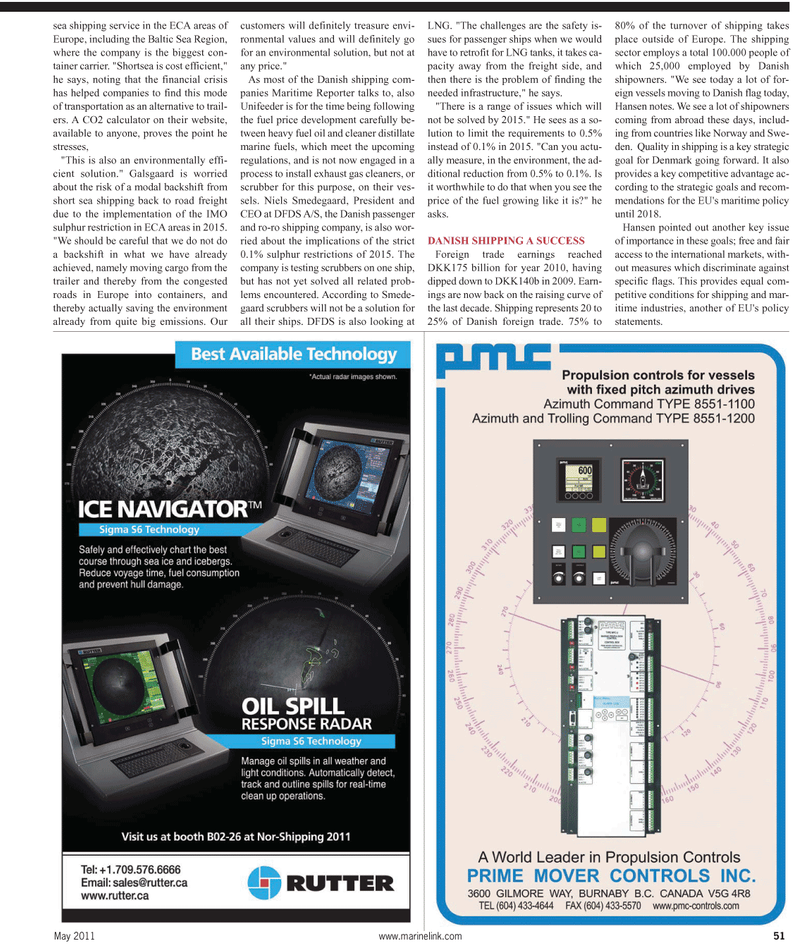
Page 51: of Maritime Reporter Magazine (May 2011)
Training & Education Edition
Read this page in Pdf, Flash or Html5 edition of May 2011 Maritime Reporter Magazine
sea shipping service in the ECA areas of
Europe, including the Baltic Sea Region, where the company is the biggest con- tainer carrier. "Shortsea is cost efficient," he says, noting that the financial crisis has helped companies to find this mode of transportation as an alternative to trail- ers. A CO2 calculator on their website, available to anyone, proves the point he stresses, "This is also an environmentally effi- cient solution." Galsgaard is worried about the risk of a modal backshift from short sea shipping back to road freight due to the implementation of the IMO sulphur restriction in ECA areas in 2015. "We should be careful that we do not do a backshift in what we have already achieved, namely moving cargo from the trailer and thereby from the congested roads in Europe into containers, and thereby actually saving the environment already from quite big emissions. Our customers will definitely treasure envi- ronmental values and will definitely go for an environmental solution, but not at any price."
As most of the Danish shipping com- panies Maritime Reporter talks to, also
Unifeeder is for the time being following the fuel price development carefully be- tween heavy fuel oil and cleaner distillate marine fuels, which meet the upcoming regulations, and is not now engaged in a process to install exhaust gas cleaners, or scrubber for this purpose, on their ves- sels. Niels Smedegaard, President and
CEO at DFDS A/S, the Danish passenger and ro-ro shipping company, is also wor- ried about the implications of the strict 0.1% sulphur restrictions of 2015. The company is testing scrubbers on one ship, but has not yet solved all related prob- lems encountered. According to Smede- gaard scrubbers will not be a solution for all their ships. DFDS is also looking at
LNG. "The challenges are the safety is- sues for passenger ships when we would have to retrofit for LNG tanks, it takes ca- pacity away from the freight side, and then there is the problem of finding the needed infrastructure," he says. "There is a range of issues which will not be solved by 2015." He sees as a so- lution to limit the requirements to 0.5% instead of 0.1% in 2015. "Can you actu- ally measure, in the environment, the ad- ditional reduction from 0.5% to 0.1%. Is it worthwhile to do that when you see the price of the fuel growing like it is?" he asks.
DANISH SHIPPING A SUCCESS
Foreign trade earnings reached
DKK175 billion for year 2010, having dipped down to DKK140b in 2009. Earn- ings are now back on the raising curve of the last decade. Shipping represents 20 to 25% of Danish foreign trade. 75% to 80% of the turnover of shipping takes place outside of Europe. The shipping sector employs a total 100.000 people of which 25,000 employed by Danish shipowners. "We see today a lot of for- eign vessels moving to Danish flag today,
Hansen notes. We see a lot of shipowners coming from abroad these days, includ- ing from countries like Norway and Swe- den. Quality in shipping is a key strategic goal for Denmark going forward. It also provides a key competitive advantage ac- cording to the strategic goals and recom- mendations for the EU's maritime policy until 2018.
Hansen pointed out another key issue of importance in these goals; free and fair access to the international markets, with- out measures which discriminate against specific flags. This provides equal com- petitive conditions for shipping and mar- itime industries, another of EU's policy statements.
May 2011 www.marinelink.com 51

 50
50

 3rd Cover
3rd Cover
